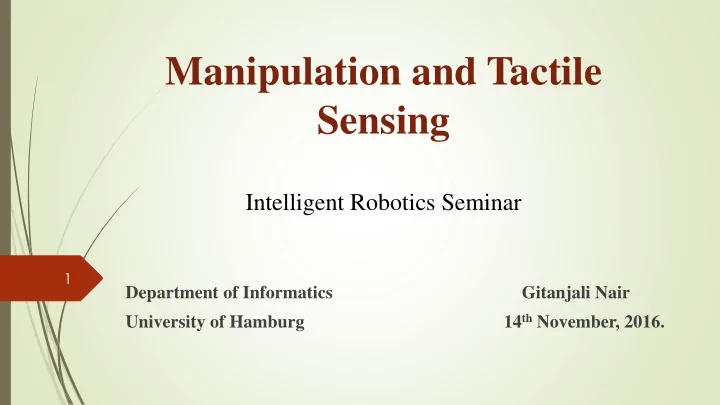

Manipulation and Tactile Sensing Intelligent Robotics Seminar 1 Department of Informatics Gitanjali Nair 14 th November, 2016. University of Hamburg
2 Outline Introduction Preliminary experiments Advanced tactile sensing and manipulation References
Introduction 3 Robotic arm Kinematic chain of base, links, joints, end flange & end effector Figure 1 : Robotic arms [3]
4 Manipulator Kinematics Position : pick & place, assembly, stacking Velocity : cutting, scanning, painting, machining Forward : find position/velocity of end effector Inverse : find joint parameter
Tactile Sensors 5 physically interact with objects detect, measure and convert information to suitable form for use in intelligent systems Figure 2 : A tactile sensor [5]
Types of Tactile Sensors 6 Normal pressure : Piezoresistive array, Capacitive array Skin deformation : Optical, Magnetic Dynamic tactile sensing : Piezoelectric (stress rate), Skin acceleration
7 Preliminary Experiments [1] Aim : Flexible and robust robotic manipulation Task : Grasp-Lift-Replace an object Proposed technology : Dynamic tactile sensors
The Manipulator 8 Figure 3 : Experimental setup [1]
Experimental Procedure 9 Pre-contact phase Loading phase Manipulation phase Unloading phase Post-contact phase
10 Figure 4 : Parameters describing phase transitions [1]
Discussion 11 Control during phase change Requirement : smooth & event-driven transitions Solution for smooth transition: sensor on outer skin, foam between accelerometer & force sensor, compliant end effector Solution for event-driven transition: dynamic tactile sensor (skin acceleration sensor)
Discussion 12 Detecting phase change One indicator may be faster or more reliable than another in a certain phase Dynamic tactile sensor helps in faster indication and deals with uncertainty of object characteristics Combination of force sensor signal and tactile sensor signal may be reliable for certain phase change detection
Observation 13 Grasp-lift manipulation is easy Challenge: smooth & flexible (event-driven) manipulation Dynamic tactile sensors must be designed to detect contact status and phase change reliably and without noise Force and position sensors are needed for gentle and flexible manipulation.
Advanced Tactile Sensing and 14 Manipulation [2] Aim : Object manipulation in an unstructured environment Task : Scraping with a spatula in an altered environment Figure 5 : Robot performing scraping task [2]
15 Proposed technology : Tactile sensing In-hand localization of object Dynamic motor primitives Perpetual coupling & tactile feedback Dimensionality reduction Policy search
Localization of object inside the robot hand 16 Pose estimation algorithms o Learn object model o Estimated object pose using learned model Here, intensity value vector of tactile image patches are used as features of object appearance Figure 5 : A tactile image [2]
Dynamic Motor Primitives (DMP) 17 Non-linear dynamic system: o Spring-damper system o Forcing function f(z) driven by canonical system z Imitation learning process Finds weights such that resultant motion resembles human demonstration
DMP (Forcing function) 18 Figure 6 : Forcing function formula [2] m -> number of Gaussian kernels w -> weight ψ -> Gaussian
Perpetual coupling & tactile feedback 19 Allows change of plan/policy at runtime though tactile feedback Tactile feedback = desired tactile trajectory – current tactile signal New forcing function = old forcing function + tactile feedback Figure 7 : Updated forcing function after tactile feedback [2]
Dimensionality reduction of tactile 20 information - Motivation Number of weights to be learnt is large Eg. Consider an 8*8 tactile image. o tactile vector length = 64 o number of Gaussians in model = 50 o number of weights to be learned for a single DMP = 64 * 50 = 3200
Dimensionality reduction of tactile 21 information - Techniques Principal component analysis : Only parts of tactile image that vary throughout task execution are considered for feedback. Weight per phase : Action is divided into phases by clustering images based on similarity. One weight is learned per phase.
Policy search for learning tactile feedback 22 weights Optimizes tactile feedback parameter weights (learn controller or robot policy) using reinforcement learning to maximize reward Here, Policy optimization is done using episodic Relative Entropy Policy Search (REPS)
Experiment 23 Task : Scraping a surface with a spatula Test 1 : Elevation of surface by 5cm Test 2 : Elevation of surface by 7.5cm (by placing a ramp) Goal : Adjust tactile feedback to the dynamically changing height by correcting pressure of spatula on surface
Working procedure : 24 o Learning from human demonstrations o For each test, 2 principle components, 3 weights (1 weight per phase of scraping task), 3 DMPs (1 DMP per dimension of 3D Cartesian space) were considered. o Number of tactile feedback weights to optimise with REPS = 18. o Policy learning process is repeated 3 times per test each consisting of 20 episodes and their resultant policy updates
Experimental Results 25 Figure 8 : Mean rewards and standard errors after each policy update [2] Robot learnt a policy which generalizes to different heights.
26 Conclusion Imitation learning and tactile feedback improves task execution (object manipulation) by robots in an altered environment.
27 Video 1 : Imitation learning and policy updation [7]
References 28 [1] Robert D. Howe, Nicolas Popp, Prasad Akella, Imin Kao, and Mark R. Cutkosky, “Grasping , manipulation, and control with tactile sensing,” in Robotics and Automation, 1990. Proceedings.,1990 IEEE International Conference. [2] Yevgen Chebotar, Oliver Kroemer, and Jan Peters, ”Learning Robot Tactile Sensing for Object Manipulation,” in 2014 IEEE/RSJ International Conference on Intelligent Robots and Systems (IROS 2014). [3] http://www.slideshare.net/robotsalive/robot-manipulation-basics [4] Mark R. Cutkosky, Robert D. Howe, and William R. Provancher. Springer Handbook ofRobotics : Force and Tactile Sensors. [5] http://www.medgadget.com/2011/11/techtouch-a-look-under-the-hood-of-an- advanced-tactile-sensor.html [6] https://studywolf.wordpress.com/2013/11/16/dynamic-movement-primitives-part- 1-the-basics/ [7] https://www.youtube.com/watch?v=Ge0GduY1rtE [8] http://www.scholarpedia.org/article/Tactile_Sensors
29 Thank You
Recommend
More recommend